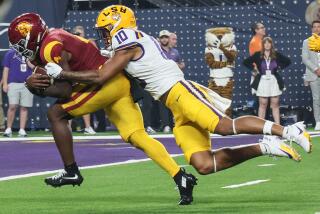Growing Pains Push TV Buttons
Would you like to be able to watch a favorite daytime soap opera during the evening, or catch a second run of a popular late-night talk show in prime time? While that may sound convenient for viewers, it’s currently one of the most heated debates within the television industry.
Television is undergoing radical change, spurred by technological advancement and an explosion of new cable channels. Meanwhile, the major networks--which each own additional cable outlets--have been flirting with ways to help program those channels through offering additional runs of their broadcast shows.
The mere concept has struck fear in the hearts of TV stations, creating tension between the networks and affiliates that carry their programs to more than 200 cities nationwide.
Stations say playing recent network fare on cable threatens to dilute their franchise as the sole provider of programs like “Seinfeld,” and have fought to maintain their exclusivity.
Meredith Broadcasting President Phil Jones, whose company owns 11 stations affiliated with three different networks, offered an analogy likening affiliates to fast-food franchises.
“It would be like McDonald’s having franchises in individual towns . . . and they decide that while the French fry truck is driving into your market, it should divert itself and be available at Joe’s Burgers and Buns,” he said.
Networks say repeating certain programs after a reasonable lapse won’t undermine broadcasters, pointing out that the networks also have an interest in maintaining broadcasting’s integrity as station owners themselves. (The ABC, CBS, NBC and Fox stations in Los Angeles, for example, are all owned by their respective network.)
Steps toward sharing programs already have occurred. Until recently, episodes of “Late Night With Conan O’Brien” were running in prime time on cable network CNBC, a month after NBC originally broadcast them. NBC also uses material from newsmagazine “Dateline NBC” a few days later on another cable channel the network owns, MSNBC.
ABC, part of the Walt Disney Co., has run children’s programs from the Disney Channel in its Saturday morning lineup and offers pay-per-view coverage of college football games from other parts of the country, competing with local network telecasts. A Californian transplanted to New York, as a result, can watch UCLA or USC play by paying a fee.
ABC also toyed with launching a soap opera channel featuring nighttime showings of popular daytime dramas such as “General Hospital” and “All My Children”--a plan that has been at least temporarily tabled.
Then there’s Fox, operator of cable networks FX, Fox News Channel and Fox Sports West. The company also is acquiring the Family Channel and intends to roll out children’s programs that it maintains will complement those on the Fox network. Even CBS, slow to exploit cable, has begun moving in that direction by agreeing to buy The Nashville Network and Country Music Television.
What’s unclear is what this means for the audience, as those within the industry wrestle over who will be the economic beneficiary of such enterprises and what the potential cost to broadcasters will be.
*
Most agree that, at present, second runs of network programs don’t necessarily have a significant impact on viewing of local stations. CNBC’s experiment with “Conan O’Brien” didn’t do particularly well, and the show’s ratings didn’t suffer on NBC during that period. Nor, apparently, has having anchors like Tom Brokaw and Katie Couric appear on MSNBC diminished NBC News.
Affiliate executives say the lingering questions raised by the concept can’t be judged by early test cases.
“The actual number of viewers might not be significant [now]. The bigger issue is a fundamental change in the relationship between networks and affiliates,” said Doug Adams, general manager of KXAS-TV in Dallas/Fort Worth and chairman of NBC’s affiliates board.
By potentially helping to further splinter the network audience--which sank to a historic low last season--stations worry that networks eventually won’t be able to afford to produce high-quality programs and that stations may become hard-pressed to provide quality news and information locally.
“If the fragmentation of audience becomes something that undermines the whole infrastructure of local television stations . . . we don’t know where that goes,” Adams said.
Networks, meanwhile, argue the opposite: The audience is fragmented, and because that trend can’t be reversed, broadcasters must seek additional revenue sources--including cable, which draws part of its income from subscriber fees--to finance programming ventures.
NBC has been at the center of the fray. The network maintains that certain programs, such as news and talk shows, have a brief shelf-life and must repeat within a few weeks of their initial broadcast.
“Our firm belief is there is a point in time in which having it on MSNBC does not hurt our affiliates,” said NBC Television Network President Neil Braun, in reference to “Dateline NBC.” “The question is, what is that time?”
Stations would like the lapse in most instances to be at least a year, and some question the value of any sharing at all. As Jones puts it, “There is technology that allows you to watch and tape things at your own leisure, but that doesn’t create a whole other competitor,” as does a new channel.
As a sign of how quickly all this is changing, the issue of repeating network shows on cable may eventually be rendered moot by what’s called “video on demand,” which would let viewers order at once whatever program they want to watch.
Under that scenario, the latest episode of “ER” would be available at any time after its initial broadcast for a nominal charge--say $1--by punching in an access code for those viewers who can’t or don’t want to set aside time to watch the show in its slot.
Executives note that securing such rights isn’t as simple as it sounds, citing copyright laws, years of custom and the Hollywood guilds that protect actors, writers and directors. Those groups are watching to make sure creative people share in money brought in by alternative means of distribution.
The implications of such services extend beyond economics, however, to popular culture. Some fear that sprinkling viewers throughout the week could eliminate chatter around the water cooler about the previous night’s “ER” or programs such as the “Ellen” coming-out episode, which was watched by more than 36 million people.
“Network television has provided the nation with a shared viewing opportunity that is an important part of our culture,” said Preston Padden, president of the ABC Television Network.
Indeed, even with ratings down, advertising rates for network television have remained high, largely because no other medium can offer such spontaneous contact.
The networks don’t want to undermine that experience but say they can’t ignore new opportunities, which are confusing but also inevitable. The transition to digital television has begun, and manufacturers are already touting the merits of receiving TV through that device.
Broadcasters continue to approach such matters cautiously. Padden hopes the digital age will provide a resolution that will be satisfactory to networks and affiliates alike, though some fear that new technology will only muddy the waters more.
As for where that leaves the audience, NBC’s Braun said: “The greatest value [the network can offer] viewers is convenience and sorting, making sense of a mixed-up, crazy world.”
More to Read
The biggest entertainment stories
Get our big stories about Hollywood, film, television, music, arts, culture and more right in your inbox as soon as they publish.
You may occasionally receive promotional content from the Los Angeles Times.










